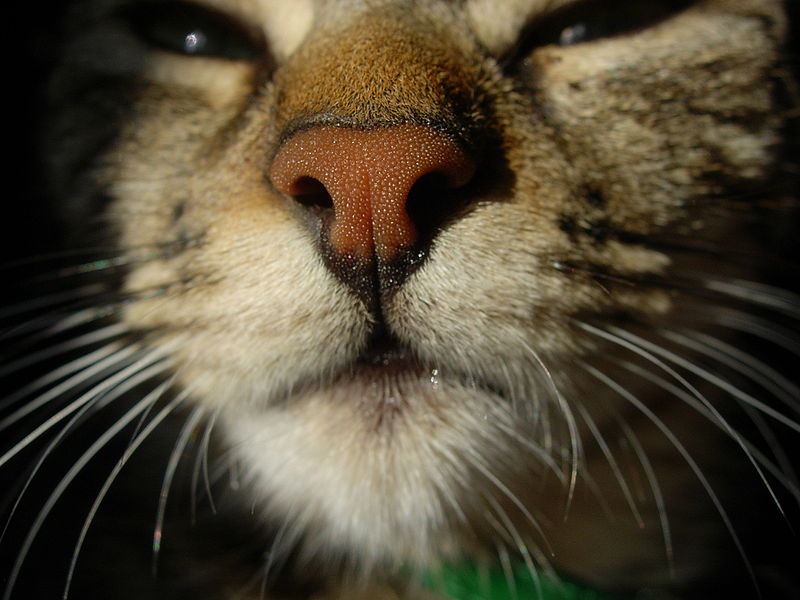Starting with this guy:
Yes, that is my cat. His name is Galileo. And he's four years-old.
He's also part of my family.
Now...many people say that about their pets. And they mean that they love them as if they were actually a "related" person.
But your pets are related to you. Everything is. In this post series, I will aim to expand minds to see what exactly our relationship is with everything around us. We're all part of a tremendously huge story. Characters in an ongoing saga, if you will. An ongoing saga of awesome.
In order to understand how we're connected to everything else, it's critical that we start out with an understanding of the last 55-80ish million years of human evolution. This will allow us to see how humans connect with the rest of the mammal world.
 | |
| A rough idea of evolution over the past 2 million years. |
Instead of a giant prehistory lesson, I'll skip over many of the various species names involved in human evolution (since many of the designations are hotly debated anyway) and just discuss the broad changes that occurred. If you're really curious, I've included a basic visual for the past 2 million years. (For those counting, I said we're going to cover nearly 80 million years of evolution. Just keep that in mind.)
Modern humans came about as a change of brain structure, mostly. Going backwards, the genus Homo as a whole came about from some brain restructuring, but honestly mostly just from our ancestors getting longer legs. This was just over 2 million years ago.
 |
| Who's that good lookin' gal? |
We split from the line to chimpanzees around 6-7 million years ago. Roughly. At the split, human ancestors adopted more of a bipedal locomotion style, while chimpanzee ancestors either retained or developed a knuckle-walking locomotion style. This was probably due to filling in different environmental niches. This whole period of time is still pretty fuzzy, though. We used to think human ancestors evolved for life in the grasslands, but that's probably not the full reality.
In any case, it's important to remember that WE DID NOT EVOLVE FROM CHIMPANZEES. That'd be like saying your cousin gave birth to you. No. That's not how it works. We share a common ancestor with chimpanzees, but chimpanzees have been evolving away from that common ancestor just as much as we humans have been!
 |
| Swinging along like a champ. Ape pride! |
But before 20 million years ago, things get fuzzy again. We know from genetic testing that apes and monkeys (that's right folks, apes are NOT monkeys) split around 30 million years ago, but the fossil record kind of stinks for a while here. We don't know exactly what we looked like during this time, but we do know what makes apes distinct from monkeys. The loss of the tail, for instance. Extra mobility in the limbs (monkeys, for the most part, can't do monkey bars, while humans, being apes, rock the socks off monkey bars). All of that came about during this time frame, from around 34-18 million years ago.
But before that, we were one and the same with the monkeys. We were not monkeys, just as we were never chimps. We were part of a group that included the ancestors of modern monkeys and apes called haplorhines. (For the nerdy among us wondering, I'm skipping over the division of catarrhines from platyrrhines 40 million years ago and going directly to our common ancestor for all monkeys and apes. Because talking about losing an premolar in the dental formula is just not that fascinating to the average person.)
 |
| A kitty cat's split lip. |
 |
| Smilodectes, roughly 50 mya. |
Unfortunately, the fossil record for primates before 58 million years ago is poor, so it's hard to say exactly when our first primate-y features showed up, or even what they were. But from the record we do have, it seems the earliest true primates had an increased reliance on vision, and greater finger/toe dexterity with opposable big toes or thumbs. The rest...well, paleontologists are still trying to figure out the rest.
So there you have it. That's us. All the way back to our split with the rest of Mammalia.
Which means we can now trace our relationship to other mammals...like my kitty cat, Galileo. But that will be for a future post. This post was just an introduction to the amazing story that connects us all. We'll need to dive deeper to see how we're related to everything else around us.
Citations:
Chatterjee HJ, Ho SYW, Barnes I, Groves C. 2009. Estimating the phylogeny and divergence times of primates using a supermatrix approach. BMC Evolutionary Biology 9: 259.
Fleagle JG. 1999.
Primate Adaptation and Evolution: Second Edition. San Diego, California:
Elsevier.
Ward CV, Begun DR, Rose
MD. 1997. Function, Phylogeny, and
Fossils: Miocene Hominoid
Evolution and Adaptations. New York: Plenum Press. New York: Plenum Press. p 1-12.

So interesting! Great humor and information.
ReplyDeleteThanks, Lauren!
Delete